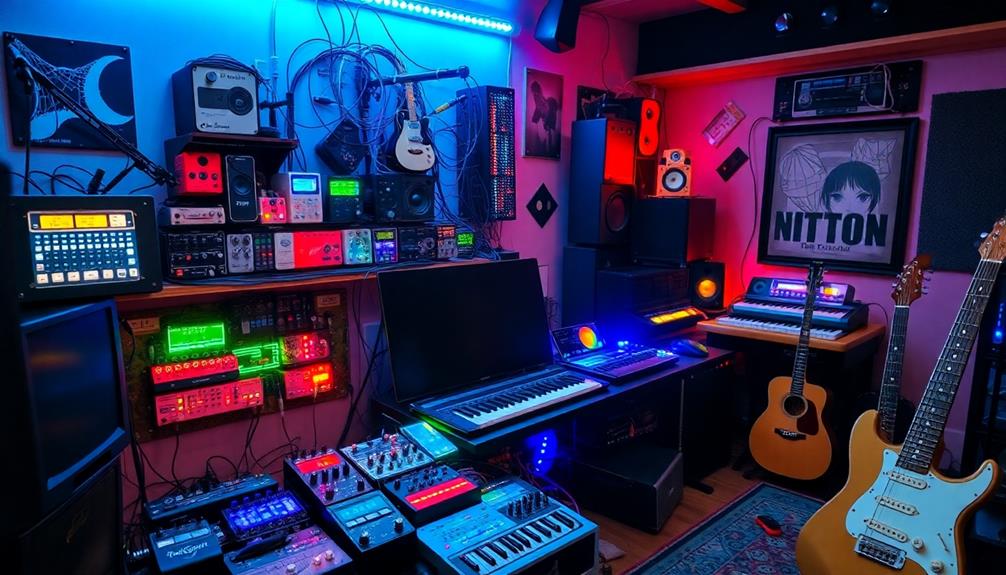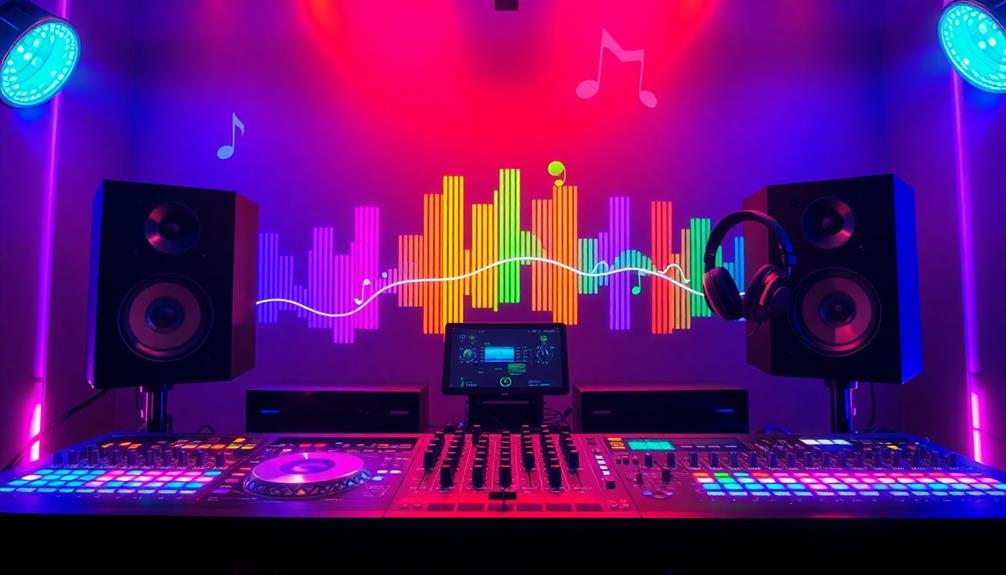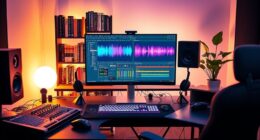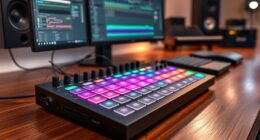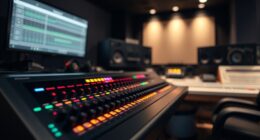Crafting your unique sound begins with designing custom effect chains that enhance your mixes. Start with pitch correction for vocals, followed by EQ for clarity and compression to control dynamics. It's crucial to manage the order of effects—try placing delay before reverb to maintain clarity. Don't forget to use a de-esser for sibilance and explore creative options like saturation for warmth. Utilizing tools like Patcher can help you customize your chains and automate effects seamlessly. With experimentation and the right techniques, you can elevate your sound. Discovering more techniques will truly transform your mixing skills.
Key Takeaways
- Begin your vocal chain with pitch correction to ensure dry vocals are optimally tuned before further processing.
- Use EQ to balance the frequency spectrum, allowing for targeted cuts or boosts for clarity and dynamics.
- Apply compression to manage dynamic range, typically aiming for 3-7 dB reduction for a polished sound.
- Incorporate delay before reverb to enhance vocal clarity while maintaining an immersive spatial effect.
- Experiment with creative processing techniques, such as saturation and automation, to craft unique and engaging soundscapes.
Understanding Vocal Chains
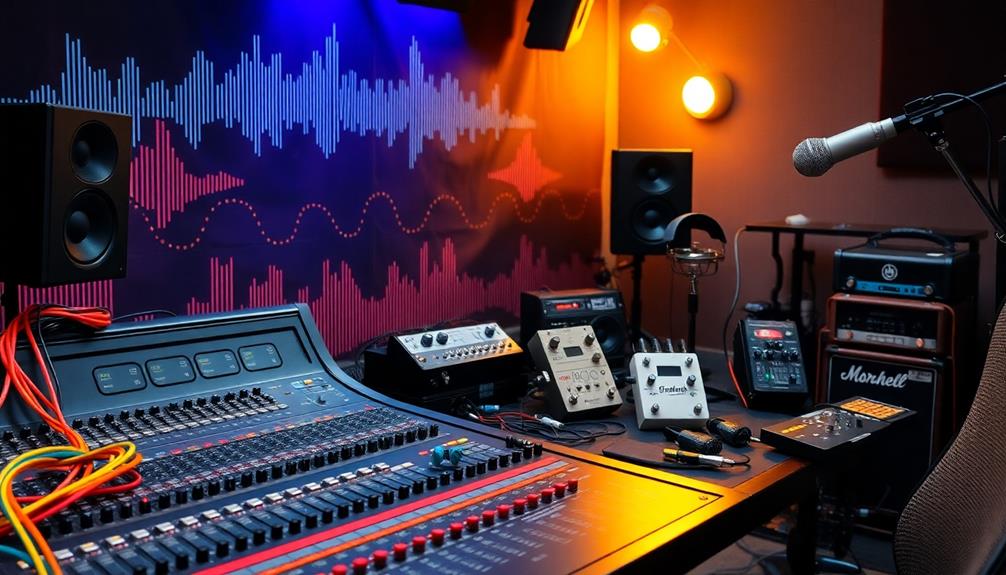
In the world of mixing, understanding vocal chains is essential for achieving polished and professional sound. A vocal chain consists of a series of processors that successively affect your dry vocals, and the order of these processors plays a critical role in the final outcome.
You should start your vocal chain with pitch correction, as it works best on completely dry vocals. By adjusting settings like Key, Register, Strength, and Speed, you can control the level of correction required for your track.
Once pitch correction is in place, the next step is equalization (EQ) to balance the frequency spectrum. This process shapes your vocals, making them clearer and more dynamic.
Following EQ, you'll want to apply compression to manage the dynamic range, typically targeting a reduction of 3-7 dB. After that, consider using a de-esser to reduce sibilance by focusing on frequencies above 3 kHz, which helps in smoothing out harsh sounds.
Essential Processing Techniques
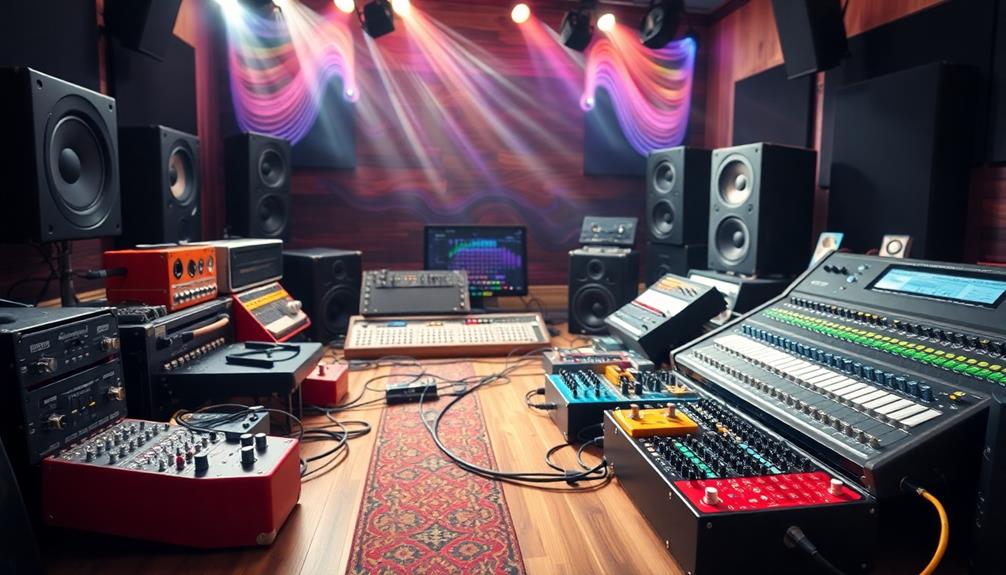
Getting the most out of your vocal tracks requires mastering essential processing techniques. First, you'll want to focus on equalization (EQ). This helps balance the frequency spectrum of vocals, allowing you to cut or boost specific bands to fit the unique timbre of the voice. Next, compression is critical for evening out the dynamic range. Aim for applying 3-7 dB of compression to maintain a natural sound without excessive pumping.
Using a de-esser is also important; it targets sibilant frequencies above 3 kHz, making your vocals smoother and less harsh. The Unmask feature in Nectar can be a game-changer, allowing you to create space for vocals by addressing competing frequencies from other instruments. Finally, don't forget about the Tame Noises feature, which effectively reduces unwanted sounds like breaths and clicks, enhancing overall clarity.
Here's a quick reference table for these essential processing techniques:
| Technique | Purpose | Key Setting |
|---|---|---|
| Equalization (EQ) | Balance frequency spectrum | Cut/boost specific bands |
| Compression | Even out dynamic range | 3-7 dB compression |
| De-essing | Reduce sibilance | Target frequencies above 3 kHz |
Advanced Features in Nectar
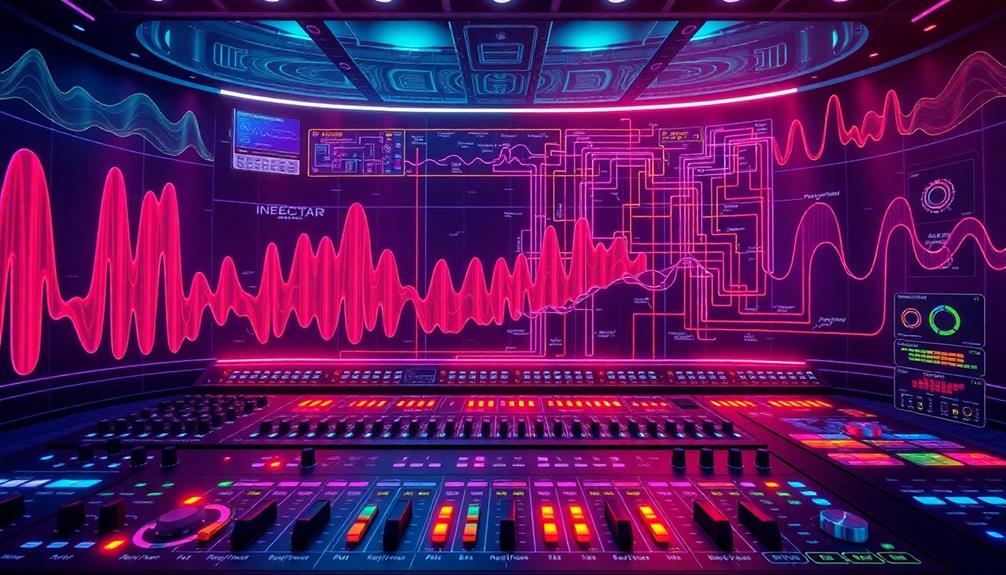
Releasing the full potential of your vocal tracks often means taking advantage of advanced features in Nectar. One standout feature is the Unmask tool, which allows you to carve out space for your vocals by creating custom EQ adjustments that effectively address competing frequencies. This guarantees your vocals shine in the mix without getting lost.
For dynamic processing, Nectar offers a variety of compressor options—Digital, Vintage, Optical, and Solid-State—letting you choose the sonic character that best fits your track. Additionally, the Auto-Level Mode (ALM) dynamically adjusts the volume, maintaining consistent vocal presence throughout your song.
Nectar also includes the Tame Noises feature, which enhances clarity by reducing unwanted sounds like breaths and clicks, elevating your production quality.
Effects in the Vocal Chain
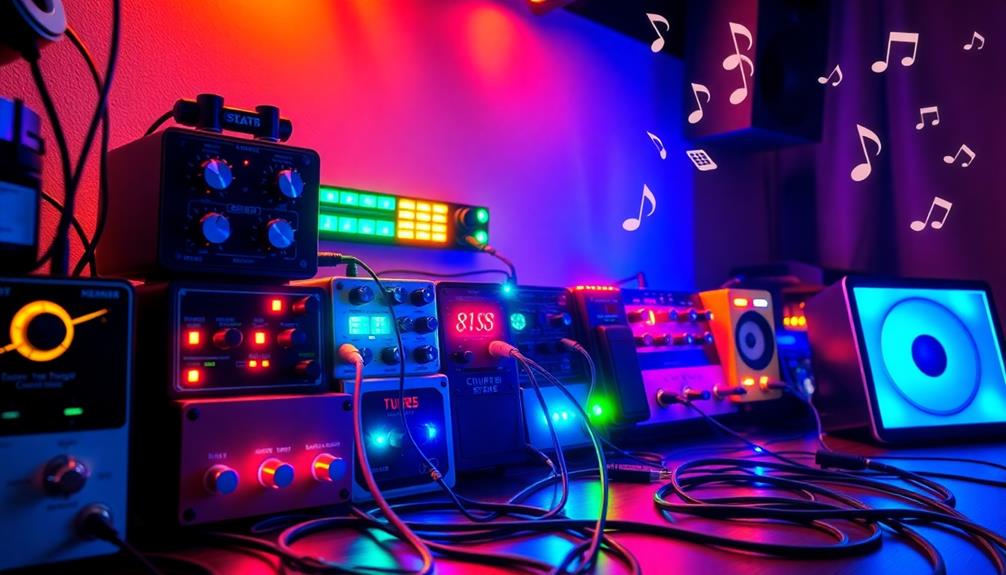
The order of effects in your vocal chain can drastically change the final sound, so it's crucial to experiment with placement.
For instance, using delay and reverb thoughtfully can enhance vocal clarity while creating a rich, immersive space.
Be mindful of how these effects interact, as the right adjustments can make all the difference in achieving that polished pro mix.
Impact of Effect Order
When crafting a vocal mix, the order of effects in your chain can dramatically influence the final sound. The impact of effect placement on processing is crucial, especially when working with delay and reverb. By placing delay before reverb, you can achieve a sense of space while maintaining vocal clarity. This arrangement helps avoid muddiness, which can easily occur with excessive reverb.
Using shorter delay times can add subtle texture to your vocals, while longer delays fill space and create a wider sound image. Fast delay settings paired with offset channels will produce a widening effect that enhances your mix. Just remember to keep your feedback knobs set to zero to prevent clutter.
Reverb should be used sparingly, as over-processing can lead to a loss of intelligibility. Carefully adjusting parameters like Pre-Delay, Decay, and Saturation is important to make sure the effect complements your vocal without overwhelming it.
Delay vs. Reverb
In the domain of vocal mixing, understanding the distinction between delay and reverb is crucial for achieving a polished sound. Delay creates a sense of space and texture in your vocals, and using it creatively can elevate your mixes to a professional level. By using shorter delay times, you can add subtle texture, while longer delays fill out the soundscape.
For those looking to enhance their recording quality, importance of high-quality equipment for sound recording can't be overstated. On the other hand, reverb smooths your vocals, but it should be applied sparingly to maintain clarity.
The order of effects in your vocal chain can dramatically influence the final mix. Placing delay before reverb enhances the spatial effect, making your vocals feel wider and more immersive. Fast delay settings, especially with offset channels, can contribute to this widening effect, while keeping feedback knobs at zero helps prevent muddiness.
When you use reverb, Nectar's Reverb module offers precise adjustments for Pre-Delay, Decay, Width, and Saturation. This guarantees that reverb enhances your vocals without overwhelming them.
However, be cautious; overusing reverb can lead to intelligibility issues. Moderation is key when applying both delay and reverb, allowing you to achieve the desired vocal sound without sacrificing clarity.
Enhancing Vocal Clarity
Achieving vocal clarity is essential for a professional mix, and the right effects in your vocal chain can make all the difference. To start, consider adding delay. Shorter delay times can enhance clarity by adding texture, while longer delays fill the mix without muddiness.
Additionally, incorporating elements that evoke themes of positivity and warmth, like in Blue Skies and Lemonade, can enhance the emotional resonance of your vocals. Next, use reverb sparingly; it smooths out vocals but can obscure intelligibility if overdone. Nectar's Reverb module allows you precise control over Pre-Delay, Decay, Width, and Saturation, letting you tailor the effect without losing clarity.
The order of effects is vital. Placing delay before reverb creates a more defined vocal sound, whereas reversing that order might muddle things up.
Don't overlook the de-esser, either. This tool targets sibilant frequencies above 3 kHz, reducing harshness and improving overall smoothness in the mix.
Creative Processing Techniques
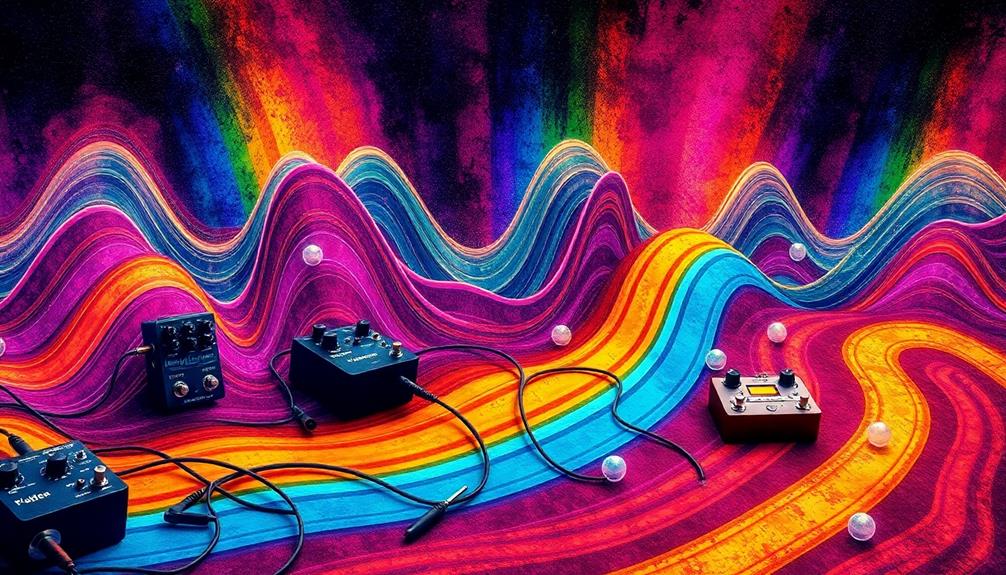
Exploring creative processing techniques can transform your mixes from ordinary to extraordinary. By incorporating saturation modules, you can add warmth and grit to your vocals, enhancing their presence and making them stand out in the mix. This simple addition can elevate your sound to the next level.
Additionally, mastering EQ techniques can greatly improve mix quality, bringing out the best in your audio tracks mastering EQ techniques.
Consider using a dimension module to introduce psychedelic effects that create expansive soundscapes. This approach not only enriches your auditory experience but also allows for unique sonic textures that keep listeners engaged.
Don't overlook the power of automation; linking controls to parameters creates dynamic and evolving effects that breathe life into your tracks. Experimenting with dry and wet chains for effects like reverb and delay lets you maintain clarity while crafting distinct textures.
Lastly, applying parametric EQ after effects can fine-tune the tonal quality of your processed audio. This guarantees your final output is polished and professional, ready for any audience.
Utilizing Patcher for Custom Chains
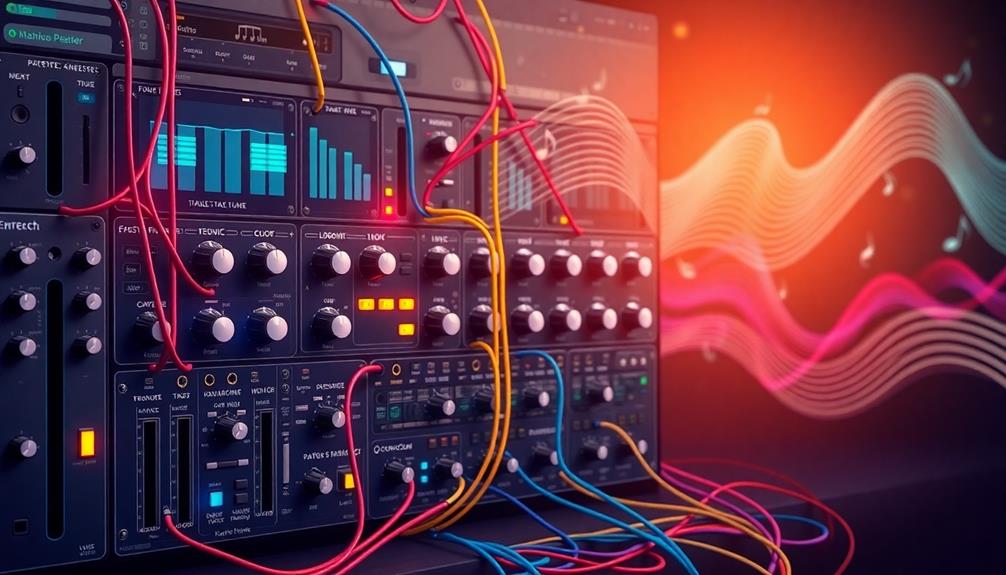
Customizing your effect chains can elevate your mixing game, and Patcher is the perfect tool to make it happen. With Patcher, you can link multiple audio effects and controls, giving you dynamic manipulation and creative routing capabilities. Imagine integrating the Fruity Peak Controller to generate LFO effects, adding movement and depth to your sound.
Here's a simple overview of Patcher's key features:
| Feature | Description |
|---|---|
| Dynamic Routing | Link multiple effects for creative processing chains. |
| Real-Time Adjustments | Trigger every knob for extensive customization. |
| Dry/Wet Chain Management | Balance effects like reverb and delay seamlessly. |
With Patcher, automation of effects becomes a breeze. You can link LFO outputs to various parameters, providing you with dynamic control over your audio effects. This not only enhances your workflow efficiency but also allows you to create polished, professional mixes. By utilizing Patcher's features effectively, you can truly craft a unique sound that stands out in your mixes. Start experimenting with custom chains today and watch your mixes transform!
Learning and Community Resources
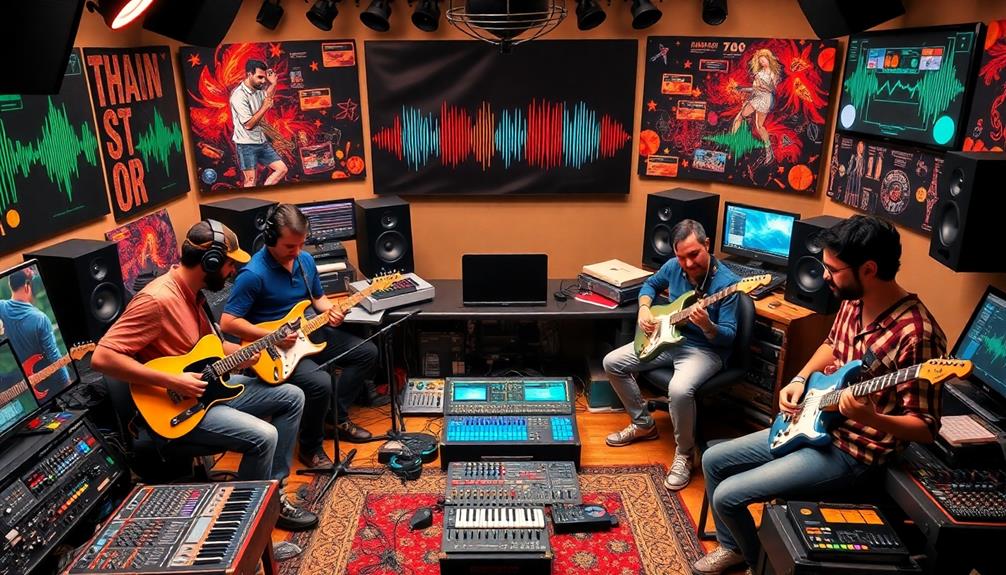
To really master custom effect chains, you'll want to explore extensive online courses that cover everything from sound design to mixing.
Engaging with community forums and groups can also provide you with valuable feedback and tips to enhance your skills.
Plus, utilizing various skill development resources will keep you updated with the latest techniques and help streamline your production workflow.
Online Courses Overview
The wealth of online courses available for FL Studio users makes it easy to enhance your production skills, no matter your starting point. These extensive resources cover essential topics like harmony, sound design, arrangement, mixing, and mastering. Keep in mind that many of these courses offer tutorials that can save you time, enabling you to learn and apply techniques more efficiently.
Additionally, you can benefit from community support, which allows for feedback and progress tracking among peers. This collaborative environment enhances your learning experience and helps you stay motivated. Continuous learning through these resources elevates your music production skills and keeps you updated with the latest industry practices.
As you progress, you'll find that you can save and improve presets over time, ensuring consistent sound design across different projects.
| Course Focus | Benefits |
|---|---|
| Harmony | Understand chord progressions |
| Mixing Techniques | Achieve professional sound |
| Sound Design | Create unique audio textures |
Explore these online courses to craft your unique sound and take your mixes to the next level!
Community Engagement Opportunities
Engaging with community resources can transform your music production experience, offering invaluable support and inspiration. When you immerse yourself in detailed courses tailored for all skill levels, you'll find topics on sound design, mixing, and mastering that can greatly enhance your production capabilities.
Feel free to explore these courses to boost your skills and confidence.
Collaborating with fellow producers on support platforms lets you receive valuable feedback and track your progress. This collaborative learning environment can accelerate your growth as you share ideas and techniques.
By participating in forums and discussion groups, you'll expose yourself to diverse methods and creative approaches to custom effect chains, broadening your understanding and enhancing your mixes.
Additionally, the tutorials and resources provided by the community can streamline your music production process, saving you ample time while sharpening your skills.
Continuous learning opportunities through online courses and workshops keep you updated on the latest trends and advancements in music production technology.
Skill Development Resources
Often, producers find that skill development resources play a crucial role in their musical journey. Whether you're a beginner or an advanced user, extensive courses in FL Studio provide structured paths covering topics like harmony, sound design, and mixing. A little bit of dedication can greatly improve your skills.
Participating in community support platforms is essential. These spaces allow you to gain feedback and insights from fellow producers, helping you track your progress. Continuous learning through various tutorials, both free and paid, guarantees you stay updated with industry trends.
Here's a quick overview of valuable resources for your growth:
| Type of Resource | Description | Benefits |
|---|---|---|
| Online Courses | Structured learning paths | Thorough knowledge and skills |
| Community Forums | Peer interaction and feedback | Networking and troubleshooting |
| Webinars | Live learning sessions with experts | Real-time insights and industry trends |
Utilizing these resources can transform your production journey, allowing you to refine your sound design and create pro mixes. Remember, every little bit of effort counts!
Frequently Asked Questions
How to Create Your Own Vocal Chain?
To create your own vocal chain, start with pitch correction, then apply EQ to balance frequencies. Next, use compression for dynamics, followed by a de-esser, and finish with delay and reverb for depth.
What Is the Most Popular Vocal Chain?
The most popular vocal chain starts with pitch correction, followed by EQ and compression. You'll add a de-esser for clarity, then sprinkle in reverb and delay, ensuring your vocals sit perfectly in the mix.
Where Should EQ Be in Vocal Chain?
EQ's a game-changer! You should place it right after pitch correction in your vocal chain. This way, you can balance frequencies perfectly, allowing your vocals to shine without clashing with other elements in the mix.
Where to Put De-Esser in Vocal Chain?
You should place the de-esser after pitch correction and EQ to effectively reduce sibilance. Experiment with its position, as placing it after compression can help control harshness, ensuring your vocals sound clear and balanced.
Conclusion
Now that you've explored the ins and outs of designing custom effect chains, don't worry if it feels overwhelming at first. You've got the tools and knowledge to experiment and find your unique sound. Remember, even the pros started somewhere! Embrace the learning process, and don't hesitate to tweak and refine your chains as you go. With practice and creativity, your mixes will evolve into something truly special, setting you apart in the music scene. Trust your ears and take the time to listen critically to how each element contributes to the overall sound. Along the way, you might discover some perfect mixing template tips that help streamline your workflow and bring consistency to your projects. Keep pushing boundaries and don’t be afraid to break the rules—your bold approach might just create the next big trend!

